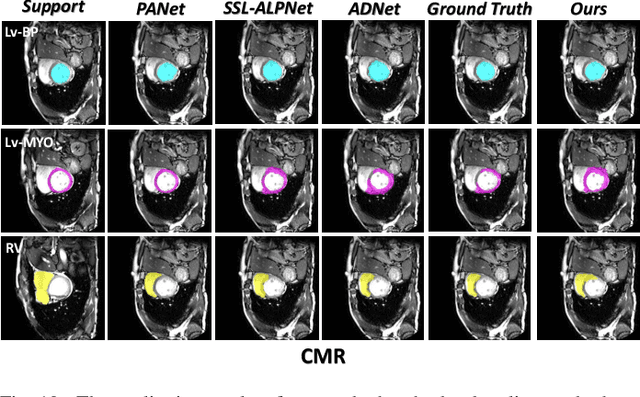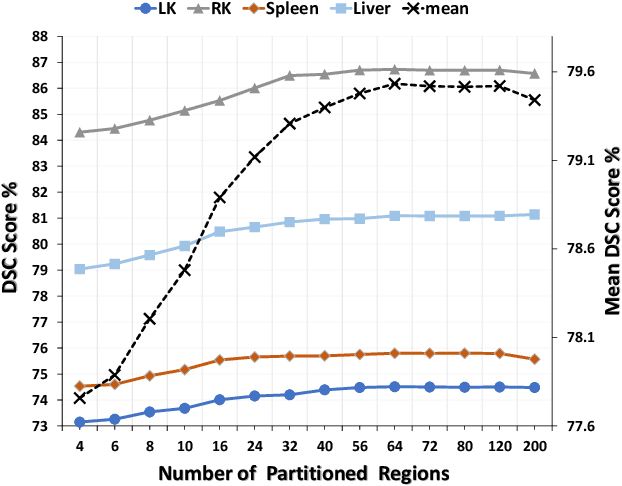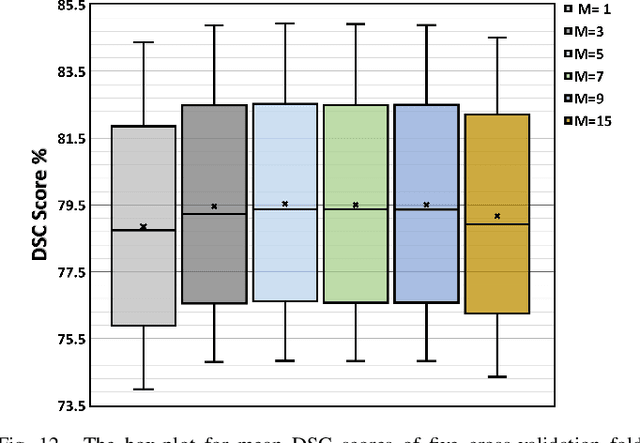Haofeng Zhang
Nanjing University of Science and Technology
FAMNet: Frequency-aware Matching Network for Cross-domain Few-shot Medical Image Segmentation
Dec 12, 2024



Abstract:Existing few-shot medical image segmentation (FSMIS) models fail to address a practical issue in medical imaging: the domain shift caused by different imaging techniques, which limits the applicability to current FSMIS tasks. To overcome this limitation, we focus on the cross-domain few-shot medical image segmentation (CD-FSMIS) task, aiming to develop a generalized model capable of adapting to a broader range of medical image segmentation scenarios with limited labeled data from the novel target domain. Inspired by the characteristics of frequency domain similarity across different domains, we propose a Frequency-aware Matching Network (FAMNet), which includes two key components: a Frequency-aware Matching (FAM) module and a Multi-Spectral Fusion (MSF) module. The FAM module tackles two problems during the meta-learning phase: 1) intra-domain variance caused by the inherent support-query bias, due to the different appearances of organs and lesions, and 2) inter-domain variance caused by different medical imaging techniques. Additionally, we design an MSF module to integrate the different frequency features decoupled by the FAM module, and further mitigate the impact of inter-domain variance on the model's segmentation performance. Combining these two modules, our FAMNet surpasses existing FSMIS models and Cross-domain Few-shot Semantic Segmentation models on three cross-domain datasets, achieving state-of-the-art performance in the CD-FSMIS task.
RobustEMD: Domain Robust Matching for Cross-domain Few-shot Medical Image Segmentation
Oct 01, 2024Abstract:Few-shot medical image segmentation (FSMIS) aims to perform the limited annotated data learning in the medical image analysis scope. Despite the progress has been achieved, current FSMIS models are all trained and deployed on the same data domain, as is not consistent with the clinical reality that medical imaging data is always across different data domains (e.g. imaging modalities, institutions and equipment sequences). How to enhance the FSMIS models to generalize well across the different specific medical imaging domains? In this paper, we focus on the matching mechanism of the few-shot semantic segmentation models and introduce an Earth Mover's Distance (EMD) calculation based domain robust matching mechanism for the cross-domain scenario. Specifically, we formulate the EMD transportation process between the foreground support-query features, the texture structure aware weights generation method, which proposes to perform the sobel based image gradient calculation over the nodes, is introduced in the EMD matching flow to restrain the domain relevant nodes. Besides, the point set level distance measurement metric is introduced to calculated the cost for the transportation from support set nodes to query set nodes. To evaluate the performance of our model, we conduct experiments on three scenarios (i.e., cross-modal, cross-sequence and cross-institution), which includes eight medical datasets and involves three body regions, and the results demonstrate that our model achieves the SoTA performance against the compared models.
Contextual Interaction via Primitive-based Adversarial Training For Compositional Zero-shot Learning
Jun 21, 2024



Abstract:Compositional Zero-shot Learning (CZSL) aims to identify novel compositions via known attribute-object pairs. The primary challenge in CZSL tasks lies in the significant discrepancies introduced by the complex interaction between the visual primitives of attribute and object, consequently decreasing the classification performance towards novel compositions. Previous remarkable works primarily addressed this issue by focusing on disentangling strategy or utilizing object-based conditional probabilities to constrain the selection space of attributes. Unfortunately, few studies have explored the problem from the perspective of modeling the mechanism of visual primitive interactions. Inspired by the success of vanilla adversarial learning in Cross-Domain Few-Shot Learning, we take a step further and devise a model-agnostic and Primitive-Based Adversarial training (PBadv) method to deal with this problem. Besides, the latest studies highlight the weakness of the perception of hard compositions even under data-balanced conditions. To this end, we propose a novel over-sampling strategy with object-similarity guidance to augment target compositional training data. We performed detailed quantitative analysis and retrieval experiments on well-established datasets, such as UT-Zappos50K, MIT-States, and C-GQA, to validate the effectiveness of our proposed method, and the state-of-the-art (SOTA) performance demonstrates the superiority of our approach. The code is available at https://github.com/lisuyi/PBadv_czsl.
Bayesian Bandit Algorithms with Approximate Inference in Stochastic Linear Bandits
Jun 20, 2024Abstract:Bayesian bandit algorithms with approximate Bayesian inference have been widely used in real-world applications. Nevertheless, their theoretical justification is less investigated in the literature, especially for contextual bandit problems. To fill this gap, we propose a general theoretical framework to analyze stochastic linear bandits in the presence of approximate inference and conduct regret analysis on two Bayesian bandit algorithms, Linear Thompson sampling (LinTS) and the extension of Bayesian Upper Confidence Bound, namely Linear Bayesian Upper Confidence Bound (LinBUCB). We demonstrate that both LinTS and LinBUCB can preserve their original rates of regret upper bound but with a sacrifice of larger constant terms when applied with approximate inference. These results hold for general Bayesian inference approaches, under the assumption that the inference error measured by two different $\alpha$-divergences is bounded. Additionally, by introducing a new definition of well-behaved distributions, we show that LinBUCB improves the regret rate of LinTS from $\tilde{O}(d^{3/2}\sqrt{T})$ to $\tilde{O}(d\sqrt{T})$, matching the minimax optimal rate. To our knowledge, this work provides the first regret bounds in the setting of stochastic linear bandits with bounded approximate inference errors.
Learning Spatial Similarity Distribution for Few-shot Object Counting
May 20, 2024



Abstract:Few-shot object counting aims to count the number of objects in a query image that belong to the same class as the given exemplar images. Existing methods compute the similarity between the query image and exemplars in the 2D spatial domain and perform regression to obtain the counting number. However, these methods overlook the rich information about the spatial distribution of similarity on the exemplar images, leading to significant impact on matching accuracy. To address this issue, we propose a network learning Spatial Similarity Distribution (SSD) for few-shot object counting, which preserves the spatial structure of exemplar features and calculates a 4D similarity pyramid point-to-point between the query features and exemplar features, capturing the complete distribution information for each point in the 4D similarity space. We propose a Similarity Learning Module (SLM) which applies the efficient center-pivot 4D convolutions on the similarity pyramid to map different similarity distributions to distinct predicted density values, thereby obtaining accurate count. Furthermore, we also introduce a Feature Cross Enhancement (FCE) module that enhances query and exemplar features mutually to improve the accuracy of feature matching. Our approach outperforms state-of-the-art methods on multiple datasets, including FSC-147 and CARPK. Code is available at https://github.com/CBalance/SSD.
Revealing the Proximate Long-Tail Distribution in Compositional Zero-Shot Learning
Dec 26, 2023Abstract:Compositional Zero-Shot Learning (CZSL) aims to transfer knowledge from seen state-object pairs to novel unseen pairs. In this process, visual bias caused by the diverse interrelationship of state-object combinations blurs their visual features, hindering the learning of distinguishable class prototypes. Prevailing methods concentrate on disentangling states and objects directly from visual features, disregarding potential enhancements that could arise from a data viewpoint. Experimentally, we unveil the results caused by the above problem closely approximate the long-tailed distribution. As a solution, we transform CZSL into a proximate class imbalance problem. We mathematically deduce the role of class prior within the long-tailed distribution in CZSL. Building upon this insight, we incorporate visual bias caused by compositions into the classifier's training and inference by estimating it as a proximate class prior. This enhancement encourages the classifier to acquire more discernible class prototypes for each composition, thereby achieving more balanced predictions. Experimental results demonstrate that our approach elevates the model's performance to the state-of-the-art level, without introducing additional parameters. Our code is available at \url{https://github.com/LanchJL/ProLT-CZSL}.
Partition-A-Medical-Image: Extracting Multiple Representative Sub-regions for Few-shot Medical Image Segmentation
Sep 20, 2023



Abstract:Few-shot Medical Image Segmentation (FSMIS) is a more promising solution for medical image segmentation tasks where high-quality annotations are naturally scarce. However, current mainstream methods primarily focus on extracting holistic representations from support images with large intra-class variations in appearance and background, and encounter difficulties in adapting to query images. In this work, we present an approach to extract multiple representative sub-regions from a given support medical image, enabling fine-grained selection over the generated image regions. Specifically, the foreground of the support image is decomposed into distinct regions, which are subsequently used to derive region-level representations via a designed Regional Prototypical Learning (RPL) module. We then introduce a novel Prototypical Representation Debiasing (PRD) module based on a two-way elimination mechanism which suppresses the disturbance of regional representations by a self-support, Multi-direction Self-debiasing (MS) block, and a support-query, Interactive Debiasing (ID) block. Finally, an Assembled Prediction (AP) module is devised to balance and integrate predictions of multiple prototypical representations learned using stacked PRD modules. Results obtained through extensive experiments on three publicly accessible medical imaging datasets demonstrate consistent improvements over the leading FSMIS methods. The source code is available at https://github.com/YazhouZhu19/PAMI.
Few-Shot Medical Image Segmentation via a Region-enhanced Prototypical Transformer
Sep 09, 2023Abstract:Automated segmentation of large volumes of medical images is often plagued by the limited availability of fully annotated data and the diversity of organ surface properties resulting from the use of different acquisition protocols for different patients. In this paper, we introduce a more promising few-shot learning-based method named Region-enhanced Prototypical Transformer (RPT) to mitigate the effects of large intra-class diversity/bias. First, a subdivision strategy is introduced to produce a collection of regional prototypes from the foreground of the support prototype. Second, a self-selection mechanism is proposed to incorporate into the Bias-alleviated Transformer (BaT) block to suppress or remove interferences present in the query prototype and regional support prototypes. By stacking BaT blocks, the proposed RPT can iteratively optimize the generated regional prototypes and finally produce rectified and more accurate global prototypes for Few-Shot Medical Image Segmentation (FSMS). Extensive experiments are conducted on three publicly available medical image datasets, and the obtained results show consistent improvements compared to state-of-the-art FSMS methods. The source code is available at: https://github.com/YazhouZhu19/RPT.
Push the Boundary of SAM: A Pseudo-label Correction Framework for Medical Segmentation
Aug 02, 2023Abstract:Segment anything model (SAM) has emerged as the leading approach for zero-shot learning in segmentation, offering the advantage of avoiding pixel-wise annotation. It is particularly appealing in medical image segmentation where annotation is laborious and expertise-demanding. However, the direct application of SAM often yields inferior results compared to conventional fully supervised segmentation networks. While using SAM generated pseudo label could also benefit the training of fully supervised segmentation, the performance is limited by the quality of pseudo labels. In this paper, we propose a novel label corruption to push the boundary of SAM-based segmentation. Our model utilizes a novel noise detection module to distinguish between noisy labels from clean labels. This enables us to correct the noisy labels using an uncertainty-based self-correction module, thereby enriching the clean training set. Finally, we retrain the network with updated labels to optimize its weights for future predictions. One key advantage of our model is its ability to train deep networks using SAM-generated pseudo labels without relying on a subset of expert-level annotations. We demonstrate the effectiveness of our proposed model on both X-ray and lung CT datasets, indicating its ability to improve segmentation accuracy and outperform baseline methods in label correction.
Efficient Uncertainty Quantification and Reduction for Over-Parameterized Neural Networks
Jun 09, 2023Abstract:Uncertainty quantification (UQ) is important for reliability assessment and enhancement of machine learning models. In deep learning, uncertainties arise not only from data, but also from the training procedure that often injects substantial noises and biases. These hinder the attainment of statistical guarantees and, moreover, impose computational challenges on UQ due to the need for repeated network retraining. Building upon the recent neural tangent kernel theory, we create statistically guaranteed schemes to principally \emph{quantify}, and \emph{remove}, the procedural uncertainty of over-parameterized neural networks with very low computation effort. In particular, our approach, based on what we call a procedural-noise-correcting (PNC) predictor, removes the procedural uncertainty by using only \emph{one} auxiliary network that is trained on a suitably labeled data set, instead of many retrained networks employed in deep ensembles. Moreover, by combining our PNC predictor with suitable light-computation resampling methods, we build several approaches to construct asymptotically exact-coverage confidence intervals using as low as four trained networks without additional overheads.
 Add to Chrome
Add to Chrome Add to Firefox
Add to Firefox Add to Edge
Add to Edge